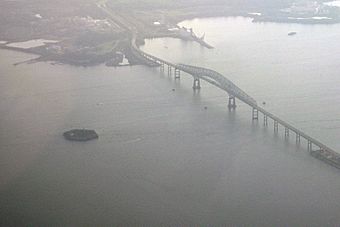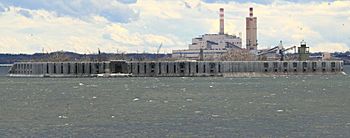Fort Carroll facts for kids
Quick facts for kids |
|
|
Fort Carroll
|
|

Fort Carroll, next to the Key Bridge in Baltimore, Maryland
|
|
| Location | Soller's Flats, in the Patapsco River, near Curtis Bay, Maryland |
|---|---|
| Area | 3.4 acres (1.4 ha) |
| NRHP reference No. | 14000955 |
| Added to NRHP | April 14, 2015 |
Fort Carroll is a 3.4-acre (1.4 ha) man-made island and an abandoned fort shaped like a hexagon. It sits in the middle of the Patapsco River, just south of Baltimore, Maryland. This fort was built to protect the coast. It is named after Charles Carroll of Carrollton, who was one of the people who signed the Declaration of Independence.
Contents
Building Fort Carroll: A Stronghold for Baltimore
In 1847, the state of Maryland allowed the U.S. War Department to build a fort. This fort was planned for the shallow waters of Soller's Point Flats. Its main job was to protect the city of Baltimore. Before Fort Carroll, Fort McHenry was the only military building defending Baltimore from the Chesapeake Bay. Fort Carroll was part of a big building plan called the "Third System." This plan aimed to protect America's most important ports.
Robert E. Lee's Role in Design
Then, Brevet-Colonel Robert E. Lee designed the fort's unique hexagonal shape. He also oversaw its construction, which began in 1848. The U.S. Army Corps of Engineers started the building work. The fort was officially named Fort Carroll on October 8, 1850. In 1852, Lee left Baltimore. He went on to become the Superintendent of the United States Military Academy at West Point.
Lighthouses and Early Challenges
In 1853, a lighthouse was built on the fort's walls. This helped ships find their way into Baltimore Harbor. A new lighthouse was built in 1898, which is the one you can still see today. It became automatic in 1920 and stopped working before 1945.
The original plan for Fort Carroll was to have about 225 cannons on three levels. However, when the Civil War started in April 1861, the fort's walls were less than half the planned height. Only five gun platforms were ready, and only two had cannons. Still, the Army placed about thirty cannons there and kept soldiers at the fort throughout the war. In April 1864, heavy rains flooded the fort's storage rooms for gunpowder. Because of this, all the powder and ammunition were moved to Fort McHenry.
Fort Carroll During the Spanish-American War
When the United States joined the Spanish–American War in 1898, soldiers were again sent to Fort Carroll. However, the cannons there were very old and not useful anymore. So, the Army began building new, modern concrete gun positions. These new designs came from the Endicott Board.
New Batteries for Defense
The Army created three new gun batteries:
- Battery Towson: This battery had two large 12-inch guns.
- Battery Heart: This one had two 5-inch guns.
- Battery Augustin: This battery held two 3-inch guns.

These new batteries were ready by September 1900. This was after the war had already ended. They received their names on March 30, 1903.
Fort Carroll: From War to Abandonment
After World War I began, the Army removed the guns from Battery Heart in 1917. In 1918, the guns from Battery Towson were also taken away to be used elsewhere. By 1920, all cannons had been removed from the fort.
Official Abandonment and New Ideas
In March 1921, the Army officially stopped using Fort Carroll. Any remaining military equipment was moved to nearby Fort Howard. In 1923, the War Department said the island was no longer needed. However, they didn't immediately sell the land. Many ideas were suggested for what to do with the island. These included turning it into a prison. In 1923, Baltimore mayor William Broening even suggested putting an electric "Welcome to Baltimore" sign on the island, along with a statue of Lord Baltimore.
World War II and Current Status
During World War II, the Army used the fort as a place for target practice. It also served as a checkpoint for ships.
In May 1958, a lawyer from Baltimore named Benjamin Eisenberg bought the island for $10,000. He wanted to build a casino there, but his plans never happened. Today, the fort is empty and deserted. It has become a home for various animals. It is also a place that people sometimes explore. In 2013, a group called Preservation Maryland added Fort Carroll to its list of historic places that are at risk. It was officially listed on the National Register of Historic Places in 2015.




